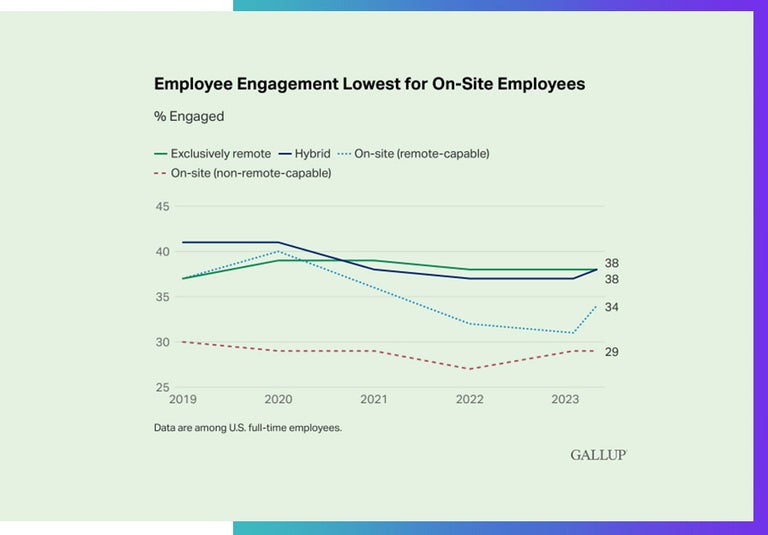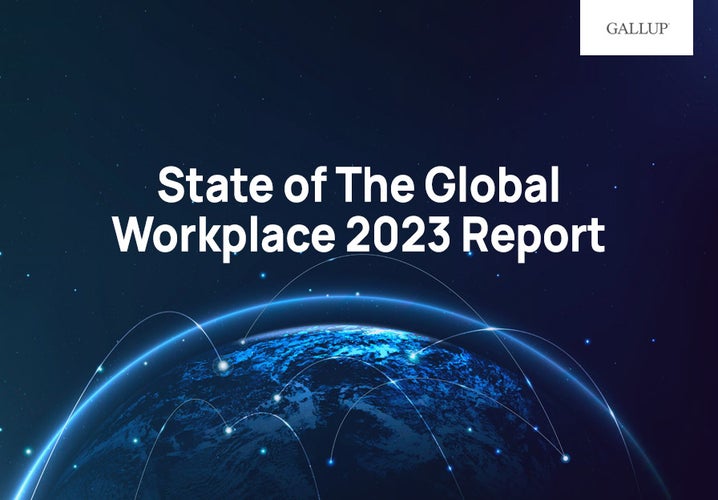Contents
- Key Finding: Most of the World is Quiet Quitting
- Key Finding: 44% of Workers are Highly Stressed Out
- The Impact of Remote vs Hybrid vs On-site Environments
- What This Means for You
Global workers are stressed out. Gallup chalks it up to high inflation in many parts of the world, and the general aftermath of pandemic madness. But one thing is clear: stress is impacting employee productivity and performance at every level.
Is WHERE people work to blame?
The State of The Global Workplace: 2023 Report was recently released with some answers.
Let’s see how stress and engagement fare in different work environments according to the latest global data.
Key Finding: Most of the World is Quiet Quitting
In general, most of the global workforce is not engaged, which means they’re all a pack of quiet quitters! Good news is that the number of thriving employees is at an all time high. Especially for people who live in South Asia (33% of them love their work).
- 23% of people are thriving at work (actively engaged)
- 59% of people are quiet quitting (no engaged)
- 18% of people are loud quitting (actively disengaged)
Key Finding: 44% of Workers are Highly Stressed Out
There’s a trend of elevated stress happening, which means that more people are more stressed than ever before. Honestly, we’re not surprised.
Is where they work part of the issue?
Here’s what we know:
- Some people find working from home more conducive to focused work
- Others focus better at the office
The office is a great place for social bonding and culture building – but you can’t beat the autonomy and wellbeing boost you get from remote work.
The Impact of Remote vs Hybrid vs On-site Environments

Thriving at Work! Engaged
Hybrid workers have the highest engagement at 34%, followed closely by fully remote workers at 32%. On-site workers have the lowest engagement at 29%.
Quiet Quitting at Work! Not Engaged
Hybrid workers lead in the 'not engaged' category at 48%. Fully remote workers follow closely at 46%. On-site workers have the lowest percentage of employees who are not engaged at 38%.
Loud Quitting at Work! Active Disengagement
Both fully remote and on-site workers share the same percentage of actively disengaged employees at 52%, while hybrid workers are slightly higher at 54%.
Quitting at Work! Overall (Average) Disengagement
On average, hybrid workers have the highest combined percentage of loud quitters and quiet quitters at 45%. Fully remote workers come next at 43%, and on-site workers have the lowest average disengagement at 38%.
What This Means for You
Hybrid Work Environment
Even though hybrid workers have the highest segment of thriving workers, they also have the highest average number of quitters who are not engaged at work.
This suggests that while a distinct portion of the hybrid workforce is winning, a lot of people aren’t faring as well.
Companies need to ask: How do individual workers feel most engaged and how can you support them?
Fully Remote Work Environment
Remote work has the middle ground in most categories. It doesn’t have the most thriving workers but also doesn't have the highest number of quitters.
The fact that remote work is firmly in the middle is telling. There are no restrictions to returning to the office – most people could do that at any time. So, the engagement issue must be related to something else - technology, management or processes.
Companies need to ask: What infrastructure or influence could improve remote engagement for my team?
On-site Work Environment
This category consistently scores the lowest in all categories, suggesting that on-site workers may be the most consistent in their feelings toward their work environment. Fewer people thrive at the office, and fewer people are quitters too.
It’s not surprising that the office comes in dead-last in terms of engagement. But it’s also harder to be disengaged there because there are so many other people around.
Companies need to ask: Why aren’t my workers thriving?

Gallup’s report brought one fundamental truth to light from 2022’s data. Leader’s need to understand that poor remote or hybrid work performance is not a location-based issue. It doesn’t matter WHERE your workforce gets things done.
What matters is whether they care and are invested in the outcomes of the work they do. Ultimately having a company full of stressed quitters is a management problem.
Stop obsessing about the WHERE and focus on the HOW.
No location can fix bad management!
For remote leaders that means investing in your management abilities, skills and techniques. If you can engage your team, your value as a leader will grow exponentially in 2024.
Or hire a talented remote manager.







